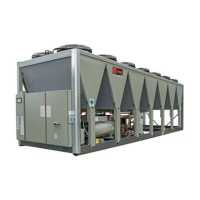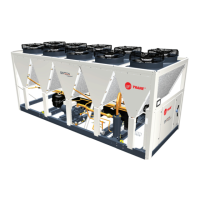Do you have a question about the Trane Sintesis Balance CMAF and is the answer not in the manual?
Introduction to the manual's purpose and scope.
Safety notices indicating potential hazards.
Guidelines to prevent injury and equipment damage.
Steps for inspecting the unit upon delivery.
Location and purpose of unit and compressor nameplates.
Listing of key components like compressors, exchangers, and controls.
Breakdown of model codes for unit size and tonnage.
Details on unit voltage, power supply, and electrical data.
Explains options for agency listing, acoustics, and application.
Description of smart communication protocols and control packages.
Pre-installation checks for unit condition and readiness.
Critical checks before initiating unit start-up.
Recommendations for storing the unit before installation.
Lists tasks for the contractor during installation.
Illustrates major components in a general view.
Shows component layout in a top view with specific options.
Illustrates component layout for XLN units with hydronic modules.
Shows component layout for SN units without hydronic modules.
Guidance on optimal unit placement for sound and airflow.
Specifies required clearances for maintenance and ventilation.
Outlines general contractor tasks for unit installation.
Procedures and precautions for safe unit handling.
Details unit dimensions, weight, and lifting points.
Requirements for foundation, leveling, and vibration isolation.
Instructions for installing optional vibration isolators.
Procedures for draining and recommendations for water treatment.
Describes piping components and shows a typical water circuit diagram.
Specifics for installing inlet/outlet water piping and components.
Details on installing pressure gauges and the flow switch.
Procedures for installing and configuring the flow switch.
Step-by-step guide for setting the flow switch.
Explains the importance of water volume for compressor operation.
How the unit handles frost formation and defrost cycles.
Managing transitions and the function of the expansion vessel.
Description of components included in integrated pump packages.
Performance curves for chilled water pumps.
Performance curves for heat recovery pumps.
Summary of freeze protection methods available.
How pumps and heaters protect against freezing.
Using glycol and draining the circuit for freeze prevention.
Adjusting unit controls for low-temperature operation.
Guidelines for selecting glycol concentration for freeze protection.
Considerations for glycol use with hydraulic modules.
Requirements for field wiring and component standards.
Critical safety warnings regarding capacitors and high voltage.
Specifications for supply voltage, imbalance, and phase sequence.
Information on unit electrical data and wiring diagrams.
Details on field-supplied power wiring and disconnects.
Requirements for supplying power to unit controls and pumps.
Information on field wiring for pump interlocks and control.
Description of programmable relay outputs for alarms and status.
How the supplemental heat option maintains warm supply temperatures.
Overview of unit components and basic operating modes.
Explanation of the refrigerant flow and oil management within the unit.
How the control system manages operating modes and capacity.
Illustrates the typical refrigerant system layout for CMAF units.
Graphical representation of unit performance limits under various conditions.
Description of the control system architecture and communication options.
How to use the operator interface for daily tasks and monitoring.
Information on the PC-based tool for advanced service tasks.
Verifying installation completeness and general unit status.
Ensuring safe electrical connections and proper voltage.
Checking supply voltage and phase imbalance limits.
Ensuring correct compressor motor rotation by checking phase sequence.
Verifying water flow rates and pressure drop across exchangers.
Specific checks for the integrated pump package before operation.
Step-by-step guide for daily unit startup.
Procedures for preparing the unit for seasonal operation.
Steps to safely restart the unit after a long period of inactivity.
Process for short-term unit shutdowns and subsequent restarts.
Guidelines for taking the unit out of service for extended periods.
Importance of scheduled maintenance for unit longevity.
Routine checks to be performed weekly on the unit.
Procedures for monthly and annual maintenance activities.
Methods to minimize refrigerant emissions during service.
Importance of correct refrigerant and oil levels for performance.
Procedures for compressor electrical connections and oil level verification.
Details on adding/removing oil, testing, and equalizer line maintenance.
Steps for replacing compressors and managing system exposure.
Diagnosing and addressing compressor mechanical and electrical failures.
Procedures for testing motor integrity and current balance.
Information on crankcase heaters and refrigerant piping practices.
Guidelines for maintaining the integrated water pumps.
Specifies lubrication needs for pump motors.
Steps for cleaning and maintaining condenser coils.
Procedures for maintaining and replacing brazed plate heat exchangers.
How to use the log sheet for performance monitoring and verification.
Services for predictive maintenance and issue diagnosis.
Services for enhancing performance and maintaining water quality.
Services for refrigerant quality and cooling tower upkeep.
Service plans offering comprehensive coverage and warranties.











